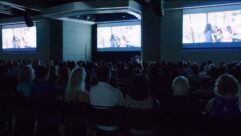
Focus on Houses of Worship: Campus-wide AV Distribution with Home-grown Talent
Oct 1, 2007 12:00 PM,
By Bennett Liles

When New Hope Baptist Church expanded to several buildings, the church needed an audio and video distribution workflow that included all the buildings on campus. Working with Media Visions, the church’s home-grown tech team put together a system that allows viewers at any location on campus to select, by channel number, the AV feeds from the sanctuary, computers showing announcements, DVD and MiniDisc players, and AM/FM radio, along with satellite feeds for news, sports, and weather.
When the New Hope Baptist Church in Fayetteville, Ga., began to expand into several buildings, a problem arose in how to distribute audio and video from an increasing number of sources to all the buildings on the growing church campus, including the sanctuary, the youth center, the dining facility, and other locations. Once funding was arranged, technical coordinator Bill Entrekin didn’t have to look far to find much of the talent necessary to build the system.
“I’ve been in construction all my life, but I have no formal training in sound, lighting, or video technology,” Entrekin says. “My son has had a keen interest in sound engineering and has taught me quite a bit. On our tech team, we have an industrial engineer, a banker, some students, a couple of airline people, and one retired police officer—and none of us have any formal video training. It’s been learn-as-you-go.”
To handle the most challenging engineering part of the task, Entrekin hired Media Visions, a Birmingham, Ala.-based firm. Once the company surveyed the task and selected the equipment, Entrekin’s tech team supplied the labor to hoist, cut, drill, and fasten it all together. Entrekin’s experience as a cabinetmaker paid off in having every video screen and TV monitor appear to have been made for the place where it was mounted. No cluttered shelves or dangling cables were allowed.
The system allows viewers at any location to select, by channel number, the AV feeds from the sanctuary, computers showing announcements, DVD and MiniDisc players, and AM/FM radio, along with satellite feeds for news, sports, and weather. There is a plasma screen on the front of the balcony for the choir and pastor to monitor during services. These are accompanied by two 12”x16” projection screens on the wall behind the choir for the congregation, four screens in the dining hall, three projection screens in the youth center, and 17 26in. TVs in the vestibules, hallways, and other common areas.
The feeds are controlled by an AutoPatch 8Y XL router in the 12”x30” video control room behind the choir, and this provides a maximum 64×64 I/O capability. Currently, the church is using only some 16 inputs and outputs, so there is plenty of room for future expansion. Mike Cruce of Media Visions had a solid reason for selecting it for the job.

In the 12”x30” video control room, the feeds are controlled by an AutoPatch 8Y XL router, which provides a maximum 64×64 I/O capability. With the church only using 16 inputs and outputs, there’s plenty of room for growth.
“We chose the AutoPatch for their industrial budget,” Cruce says, “because we’ve used it before and found it to be very reliable and a good piece to work with.” And the AutoPatch router carries a load as the heart of the system.
“Every piece of gear that we have dumps into that router for audio and video that we might want to feed to any portion of our building,” Entrekin says. “We have two satellite dishes that feed different distribution signals, and we broadcast onto the system through five local TV channels.”
Graphics are also a priority for distribution. “Through two computers in that room, we put PowerPoints, words to hymns, announcements, and such on the screens for the congregation,” he explains. “[At the same time,] we broadcast a camera shot to the lobby and common areas for people coming in late or who might have to take children out there. They can still watch the service from there. In the more remote areas, we broadcast announcements that are run on the second computer that whole time.” The computers are fed through two Extron VSC-200 scan converters that scale the signals for the projection screens, and then the signals are spread around the campus network.
“Those signals go into a series of distribution amplifiers, and that goes out through coax straight to the TV monitors we have around the building, and some of those lines are 1,500ft. to 2,000ft. long.”

Using two satellite dishes and five local TV channels, the church is able to distribute PowerPoint presentations, hymns, and announcements to other areas of the campus.
Setting all this up when a church is first being built is much simpler. The real challenge comes when trying to upgrade and modernize the current facility. The older structure doesn’t always fully cooperate, and Entrekin’s team had some problems to solve.
“A significant challenge was trying to retrofit the building. Trying to find a path for wiring. Trying to find conduits and mounting locations that were not originally planned in the structure of the building—that’s a tremendous challenge,”
Entrekin says. But Entrekin’s team took the job head-on, and they never thought that it was more than they could handle. In that, Entrekin offers some advice. “I would encourage any church or any group of people who think for whatever reason that they can’t, they’re not equipped, they don’t have the knowledge, that—in fact—they can,” he says. “There’s no harm in pushing the wrong button and learning what not to do. That’s a good education, and it’s amazing what people can do with that kind of attitude and a joint effort.”
And if a church is willing to invest in its relationship with an established design firm such as Media Visions, the rest comes much easier. At New Hope, that effort paid off.










